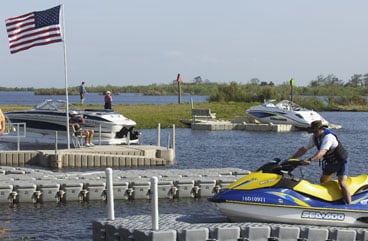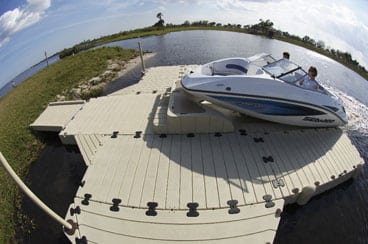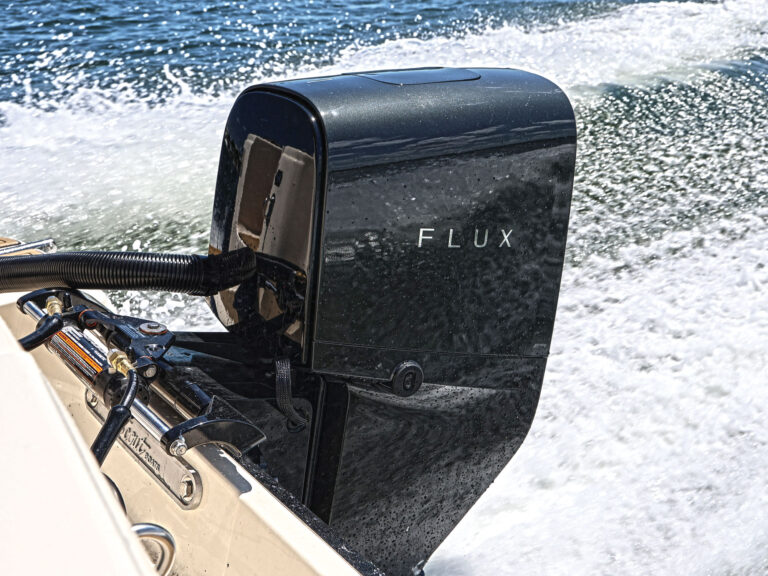Where I come from, Lake of the Ozarks in central Missouri, water levels normally fluctuate about 10 feet during the season, and to deal with it floating docks are key. In fact, on all impoundments, floating docks have been raised to an art form by necessity. When the water goes up or down, the dock has to go with it.
Floating docks aren’t restricted to the South, either. Boaters have also turned to them in the North, where freezing lakes can damage piers. Some floating docks, like the VersaDock models, can be left in all winter.
“More than 80 percent of our northern installations stay in all winter,” says Teo Leonard, president of president of VersaDock. “They pop up on top as the ice puts on the squeeze.”
Other systems, like the EZ Dock systems we tested, can be rolled up on shore on special wheels that remain in place year-round.
Still another feature of floating docks intrigued us. We wanted to test drive-on boat hoists that would lift boats out of the water when we were through with them. Did they work? Was there a trick to it? And would the average boater like such an arrangement?
With the five top dockmakers in place, we converged on Okeechobee at a lagoon we’ll call Home Port. Our plan was to make it all happen in one day.
Putting It All Together
On the morning of our test, thick fog blanketed Okeetantee Park on the northern tip of Lake Okeechobee. It hovers on our lagoon until well past our scheduled 7 a.m. starting time. Piles of dock segments are stacked on trailers and along the shore. Cartons of connectors, hardware and tools, and dozens of dock builders wait for our “go.” We watch an 8-foot alligator stalk a shorebird and then drop out of sight when the heron catches his drift and flies away. Fog or no fog, after two hours of waiting, it’s time for action.
9:00 a.m.
If we’d waited longer, we didn’t think our crews would have time to get the docks built by sunset. In a half hour we’d know how wrong we were. At the starting gun, the gangs start sliding dock segments into the water.
9:05 a.m.
Eric Laviollette of CanDock begins sliding sections of dock into the water, each cube weighing 14 pounds. “We usually ship much of our dock to our customers already assembled,” he says while he and his partner slide the next section into the water.
VersaDock, a brand with similar modular cube-shaped flotation sections, follows suit. ShoreMaster’s team, however, works diligently on shore, considering the ideal location of pilings and arranging their connectors.
“Somebody hand me a drill,” says Kevin Viscardi as he slips into the water where moments earlier our gator
disappeared. I cringe, but he begins tightening connectors made of a durable polymer. They fasten each entire side of a floating module to the side of the adjoining module, clamping them tightly together at top and bottom. For a neat touch, the connectors have a wood-grain finish, and the floating modules look like brick pavers. The styling is first-class.
9:07 a.m.
At the SportPort station three modules are quickly fastened together to form the boat dock/hoist. In less than a half hour they’ve completed that and hitched in a PWC port as well. Nearly all of the components are of rust-proof polymer, though we notice a few dozen stainless-steel bolts are used to hold things together. For SportPort, this would become “Dock in a Few Minutes.”
“Our docks are primarily used alongside permanent docks,” says Dave Reuckert, “so we don’t make ramps for them. There are no working parts on them, and that adds to their durability, especially in salt water.”
9:10 a.m.
In just 10 minutes, each crew has at least half of its project floating. We begin to fantasize about spending the rest of the day touring Okeechobee, which though still painted in fog entices us to jump into a boat to explore. We could return to one of the magically appearing docks, the most elaborate being the EZ Dock, which has hoists for our Tahoe Q7i and for a SeaDoo GTX Si personal watercraft.
9:20 a.m.
Sharon Wharmond of EZ Dock headquarters is part of the crew assembling the dock and boat lifts.
“We can’t really call the lifts ‘hoists,’ so we came up with EZ Port,” she explains. The six men in her crew are working like log rollers, putting modules in place without ever getting wet. They use a special tool to hold “dog bone” connectors in sockets below the deck while another hand bolts in another bone above the deck. These shock-absorbing connectors of heavy rubber are sacrificial, saving the flotation modules from damage when the water gets too rough.
9:30 a.m.
SportPort is mopping up, removing the footprints of Okeechobee muck from their dock. A few swishes of water does the job.
Back at the CanDock station, Eric is spinning round connectors in with an electric drill. His confidence in the stability of his project shows – the drill isn’t cordless; it’s powered by 110 volts of AC current from the generator onshore. Eric has brought his dock in more pieces and is running a shorter crew than EZ Dock, but that doesn’t stop the rest of the gang from giving him a dig.
“We don’t need power tools to put ours together,” says Teo Leonard of VersaDock. Though the connectors use similar bits, the VersaDock crew uses a T-handle wrench and spins in the handful of connectors by hand, taking advantage of a third man on the crew. All the connectors can be fastened above the water, so no one has to tempt the gator with fluttering hands below.
9:45 a.m.
The SportPort crew makes a beeline for the refreshment station. Their dock is done. I’m standing on shore, eager to slip a boat up on the slip … er, port. These drive-on docking systems look very intriguing.
9:50 a.m.
Two members of Team EZ Dock drop the last piling while the rest of the crew swabs the deck.
9:55 a.m.
It’s high fives at EZ Dock and the crew heads for the cooler. Before we can turn back to ShoreMaster, the EZ Dock guys are fishing from the dock.
10:00 a.m.
The week after the events of 9/11, I was on Lake Wawasee in Syracuse, Indiana, virtually every dock on the lake had an American flag fluttering in the crystal morning sunlight. A few had flags of their favorite college football teams, too. Nothing looks better on the dock than your home colors waving in the breeze. An hour after they started, the ShoreMaster squad is raising theirs. All the docks are ready for testing.
The sun pops out and with it the sweltering heat. We police the lagoon grounds, clearing away tools and containers. It takes longer to clean up our gear than it did to assemble our docks. We break for lunch before giving the docks a walk-on and drive-on test.
Our Eye On The Field
Given our five contestants, we had to keep in mind that these were not really apples to apples comparisons. All the dock builders have decidedly different looks and applications. But all of them have their niche, and here’s what we learned about them.

Aesthetics
Maybe it was the American flag fluttering in the breeze, but the ShoreMaster stood out as a beautiful dock. We liked the brick-paver look molded into the deck and the wood-grained connectors.
EZ Dock runs neck and neck with ShoreMaster in aesthetics, and perhaps a fluttering banner would have made the decision harder to make. They, too, have a stylized surface that gives the dock a homey, traditional look.
SportPort’s clean white surface and minimum parts made this one stand out aesthetically, too. Their systems are designed to partner with piered docks, so they don’t come with walkways.
Admittedly, there is something a bit more industrial to the look of the VersaDock and CanDock system. A long and strong record for durability is the upshot. Both companies have many huge public marinas under their belts, and the versatility makes them a strong choice for residential docks, too.
Accessories
EZ Dock was the winner here. The boat float for rigs up to 3,000 pounds and the convenient PWC port would cover most boaters’ needs. We like the dock boxes at the bow that secure gear and offer a convenient step to dock level. Handy fenders keep moored boats from riding up on the dock.
ShoreMaster also has handsome fenders and an awesome PWC hoist. They opt to make floating and winch hoists rather than drive-on models, and those weren’t as convenient to install at our location, so we didn’t get to test them.
VersaDock’s strengths lay in the patented half-cubes with V-entries. These components made it easy to drive on our boats, but in the accessories department we were looking for integrated fenders, benches and storage compartments which VersaDock lacked. On the other hand, the round edges of the cubes would very likely be as easy on a boat hull as a fender.
CanDock’s cube system is also cleanly simple without attached fenders or adornments. Every dock had a winch system in place, so we could easily return the jetdrive Sea-Doo Challenger to the water. CanDock invented one for their system the week before arrival, and it can be positioned anywhere on the dock. It will become a normal accessory for their system.
SportPort is decidedly simple in construction; accessories were limited to the winch. However, the system worked so well when used in conjunction with other docks that we think its continued popularity is inevitable.
Drive-On Ease
We found SportPort made launching and landing the boat easy for both the 3,000-pound Tahoe Q7i and the lighter Sea-Doo Challenger. There was a steep step up and step down when loading and unloading the boats, but once we found the right speed of about 1,500 to 1,700 rpm, the Tahoe settled nicely onto the dock and stayed there. PWC landings were a snap, and all craft were held high out of the water for dry storage.
VersaDock was also an easy-loading dock at similar speeds. The step up wasn’t as steep as other docks, though, thanks to patented V-entry half-cubes with a notch which made lining the boat up on the dock easy; it also reduced the step up to the surface. The Tahoe was a snap to load and unload, and this dock can be configured to accept much heavier boats.
CanDock has a steeper step to load and unload, but the buoyancy makes it an ideal dock for large boats. The step up requires a pretty hot throttle of between 1,700 and 2,000 rpm.
ShoreMaster only makes drive-on watercraft ports, and they worked fine. A roller at the entry point made the step up easy, and once in place, the Sea-Doo stayed put.
EZ Dock also used rollers on boat and PWC ports. The trick is to nudge the boat gently against the roller and then accelerate to 1,500 to 1,700 rpm (or maybe a little more) and hold it there while the boat walks up the roller. Hit the entry point too hard and you’ll be replacing a roller.
There are common threads among all drive-ons. First, you need to ease the bow against the entry point with a minium bump. Second, it’s better to undershoot the landing than overshoot it. After a few landings, hitting the target every time was easy. We could shove most boats off either by jogging aft in the boat and stopping suddenly, or by leaning against the bow and nudging stiffly. All drive-ons come with a winch that applies the reverse force to back it out for smaller drivers.
We liked the way the rollers worked on the ShoreMaster and EZ Dock, but if heavy boats hold them in the water in a salt environment, fouling could disrupt the action of the roller and barnacles could scrape the boat. SportPort, VersaDock and CanDock are top choices for saltwater use.

Stability
ShoreMaster and EZ Dock were the hands-down favorites for walk-around stability. Multiple connection points on the EZ Dock and contiguous connection strips on the ShoreMaster system give them a solid one-piece feel and a smooth surface. ShoreMaster’s triangular corner braces at the walkway also ease traffic flow, and we think they’ll lower the likelihood of accidents as boaters inevitably cut the corner.
Still, the CanDock and VersaDock gave us the largest and widest platforms, and that made them comfortable to walk on as well.
SportPort’s system gives easy boarding from the side or bow and we felt secure as we walked on or off. Easy walking came from fewer joints between the components, and we liked the system.
Big-Boat Capacity
In terms of drive-on docking, only VersaDock can accommodate practically any size boat. By adding modules lengthwise and width-wise, capacities can be increased to well beyond the 3,000-pound 20-footer we drove onto it. Half blocks and beveled entries made loading easy. CanDock is also expandable, ready to lengthen or broaden their layouts to fit larger boats. Our test dock, in fact, would have been much happier with a larger boat than our Tahoe.
SportPort, too, can adjust their system upward by adding more length. Our boats floated high and dry over the water, and with the stern-drive trimmed nothing touched the H2O.
While ShoreMaster can adjust their platform size, they opt for hydraulic hoists that can sink under the boat and then be floated upward by pumping in air and forcing out the water ballast. These systems have worked very well for us in the past, but we were unable to test them in our shallow lagoon.
EZ Dock’s EZ Port was limited to boats about the size of our Tahoe. They brought two entry points to the test, one better suited to the lighter Challenger and one for the Tahoe.
Apples to Apples
If we had a wish, we’d wish these systems were as similar as apples so we could take a bite and announce the winner. What we found is each system has benefits that others can’t claim. For saltwater applications, we’d lean toward SportPort, VersaDock and CanDock. Where boat sizes allow it, the EZ Dock provides an attractive and convenient platform, plus easy boat storage. ShoreMaster, coupled with a hydraulic hoist, would be the best solution in deeper water found in impoundments like Lake of the Ozarks. That may be why ShoreMaster sprung up near that sprawling fluctuating lake.
| 5 Players of Dock In A Day CanDock: candock.com, 888-547-2599EZ Dock: ez-dock.com, 888-752-9349ShoreMaster: shoremaster.com, 800-328-8945.SportPort: sportport.com, 888-949-9675VersaDock: versadock.com, 866-999-3625 |








